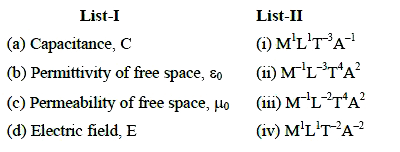Match List I with List II of Electromagnetic waves with corresponding wavelength range:
Choose the correct answer from the options given below:
A−I,B−IV,C−II,D−III
A−IV,B−I,C−III,D−II
A−IV,B−I,C−II,D−III
A−IV,B−II,C−I,D−III
To solve the problem of matching electromagnetic waves with their corresponding wavelength ranges, we can follow these steps:
Step 1: Identify the Wavelength Ranges for Each Type of Electromagnetic Wave
1. Microwave: The wavelength range for microwaves is typically from 1 millimeter (1 mm) to 0.1 meter (or 100 mm). Therefore, we can express this as:
Microwave: 1 mm to 0.1 m (or 100 mm)
2. Ultraviolet (UV) Rays: The wavelength range for UV rays is from 400 nanometers (nm) to 1 nanometer (nm). Thus, we can write:
Ultraviolet: 400 nm to 1 nm
3. X-rays: The wavelength range for X-rays is from 1 nanometer (nm) to 1 picometer (pm). This can be expressed as:
X-ray: 1 nm to 1 pm
4. Infrared (IR): The wavelength range for infrared waves is from 1 millimeter (mm) to 700 nanometers (nm). Therefore, we can state:
Infrared: 1 mm to 700 nm
Step 2: Match Each Wave with the Correct Wavelength Range
Now we can match the identified ranges with the options provided:
- Microwave: 1 mm to 0.1 m (matches with option 4)
- Ultraviolet: 400 nm to 1 nm (matches with option 1)
- X-ray: 1 nm to 1 pm (matches with option 2)
- Infrared: 1 mm to 700 nm (matches with option 3)
Step 3: Compile the Final Matches
Based on the above analysis, we can summarize the matches as follows:
- Microwave: 4
- Ultraviolet: 1
- X-ray: 2
- Infrared: 3
Conclusion
The correct matching of List I with List II is:
- Microwave → 4
- Ultraviolet → 1
- X-ray → 2
- Infrared → 3
Thus, the final answer is option number 3.
---
Microwave: 1 mm to 0.1 m (or 100 mm)
Ultraviolet: 400 nm to 1 nm
X-ray: 1 nm to 1 pm
Infrared: 1 mm to 700 nm
- Ultraviolet: 400 nm to 1 nm (matches with option 1)
- X-ray: 1 nm to 1 pm (matches with option 2)
- Infrared: 1 mm to 700 nm (matches with option 3)
- Ultraviolet: 1
- X-ray: 2
- Infrared: 3
- Microwave → 4
- Ultraviolet → 1
- X-ray → 2
- Infrared → 3
Topper's Solved these Questions
Similar Questions
Knowledge Check
- Question 1 - Select One
Match List I with List II.

Choose the correct answer from the options given belowA(a) → (iii), (b) → (ii), (c ) → (iv), (d) → (i)B(a) → (iii), (b) → (iv), (c ) → (ii), (d) → (i)C(a) → (iv), (b) → (ii), (c ) → (iii), (d) → (i)D(a) → (iv), (b) → (iii), (c ) → (ii), (d) → (i)
Match List-I with List-II

Choose the correct answer from the options given below:View SolutionMatch List-I with List-II

Choose the correct answer from the options given below:View SolutionMatch List-I with List-II

Choose the correct answer from the options given belowView SolutionMatch List-I with List-II

Choose the correct answer from the options given below:View SolutionMatch List I with List II.

Choose the correct answer from the options given below :View SolutionMatch List I with List II.

Choose the correct answer from the options given below :View SolutionMatch List I with List II :

Choose the correct answer from the options given below :View Solution



